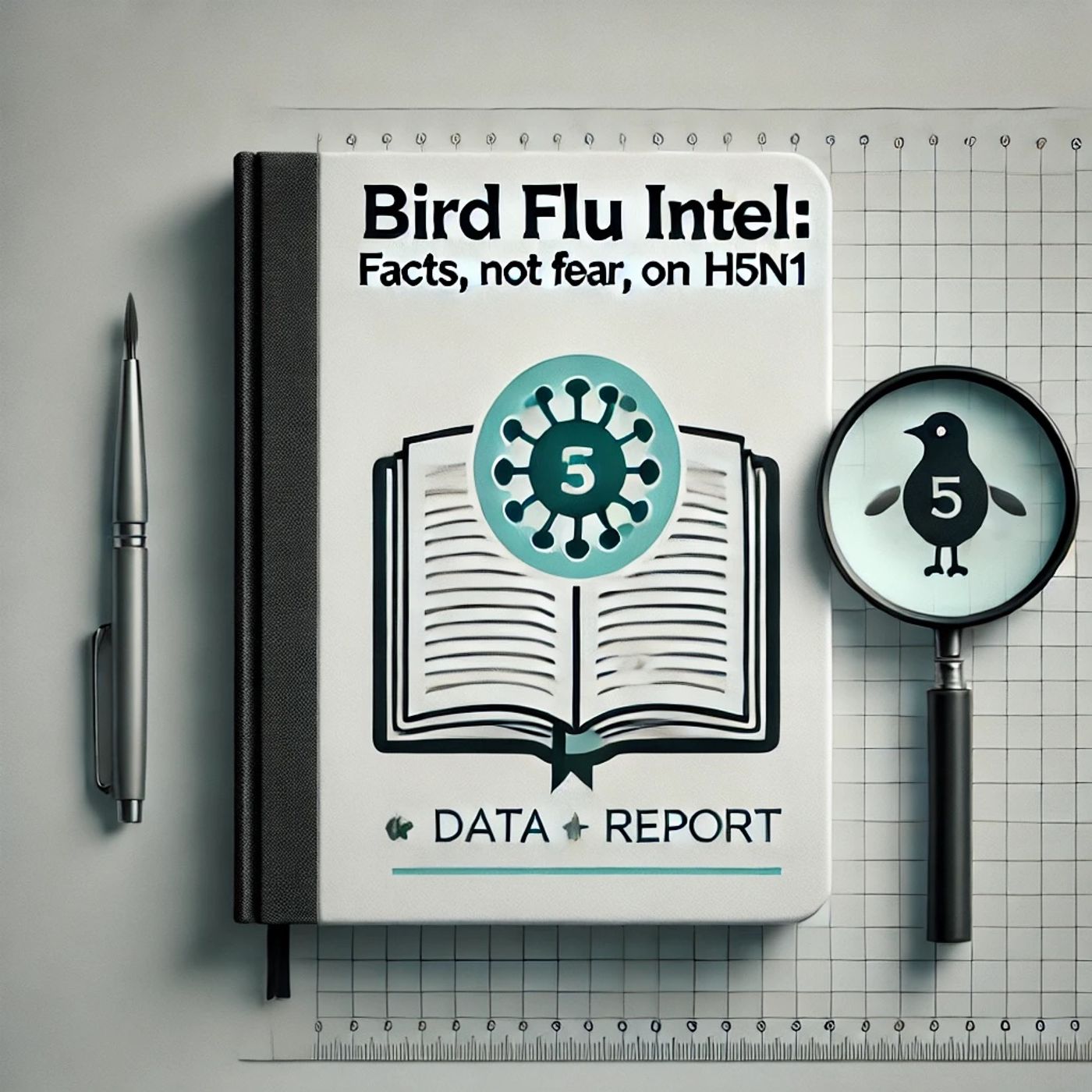H5N1 Bird Flu Facts: Understanding the Current Outbreak and Separating Science from Sensationalism
Update: 2025-10-01
Description
Bird Flu Intel: Facts, Not Fear, on H5N1
Welcome to Bird Flu Intel, where we cut through the noise with science-based facts about H5N1 avian influenza. I'm your host, and today we're busting myths that could put you and your community at risk.
First myth: H5N1 is spreading rapidly between humans. The truth? The CDC and WHO confirm zero cases of sustained human-to-human transmission. In 2024, 66 Americans were diagnosed with H5N1, all from direct animal contact, not person-to-person spread. While a Louisiana resident died in January 2025, this tragic case still involved poultry exposure, not human transmission.
Second myth: All milk is dangerous now. False. Pasteurization completely eliminates H5N1 virus from milk. The CDC emphasizes that pasteurized dairy products remain safe for consumption. Only raw, unpasteurized milk poses risk, which health officials have warned against long before H5N1.
Third myth: H5N1 will definitely cause the next pandemic. While scientists monitor this closely, the virus hasn't acquired mutations necessary for efficient human transmission. The National Center for Biotechnology Information notes that despite genetic diversity in H5N1 strains, sustained human spread remains undocumented.
Fourth myth: Bird flu vaccines don't work. Research shows next-generation vaccine platforms and stockpiled prepandemic vaccines demonstrate efficacy against H5N1 strains. The WHO continues advancing clinical trials as part of preparedness efforts.
Why does misinformation spread so easily? Social media algorithms amplify sensational content, fear-based headlines get more clicks, and complex scientific concepts get oversimplified. This creates real harm by causing unnecessary panic, reducing trust in public health guidance, and potentially leading people to make dangerous decisions like avoiding necessary medical care.
Here's how to evaluate H5N1 information quality: Check if sources cite peer-reviewed research, look for quotes from epidemiologists or virologists at major institutions, verify information appears on CDC, WHO, or university websites, and be skeptical of headlines using absolute terms like "always" or "never."
The current scientific consensus is clear. H5N1 poses primarily animal health concerns with limited human cases from direct animal contact. Most human infections remain mild, typically causing conjunctivitis. Risk to the general public remains low, though dairy and poultry workers face elevated exposure risks.
Where legitimate uncertainty exists: Scientists continue studying viral mutations, monitoring potential for increased human transmissibility, evaluating optimal surveillance strategies, and developing universal influenza vaccines. The Barnstable County government notes that while no Massachusetts cases have occurred, widespread bird infections require ongoing vigilance.
The key takeaway? Stay informed through credible sources, follow basic hygiene practices around animals, avoid raw dairy products, and don't let fear override facts. Current H5N1 activity requires attention and preparation, not panic.
Thanks for tuning in to Bird Flu Intel. Come back next week for more myth-busting science. This has been a Quiet Please production. For more, check out Quiet Please Dot A I.
For more http://www.quietplease.ai
Get the best deals https://amzn.to/3ODvOta
This content was created in partnership and with the help of Artificial Intelligence AI
Welcome to Bird Flu Intel, where we cut through the noise with science-based facts about H5N1 avian influenza. I'm your host, and today we're busting myths that could put you and your community at risk.
First myth: H5N1 is spreading rapidly between humans. The truth? The CDC and WHO confirm zero cases of sustained human-to-human transmission. In 2024, 66 Americans were diagnosed with H5N1, all from direct animal contact, not person-to-person spread. While a Louisiana resident died in January 2025, this tragic case still involved poultry exposure, not human transmission.
Second myth: All milk is dangerous now. False. Pasteurization completely eliminates H5N1 virus from milk. The CDC emphasizes that pasteurized dairy products remain safe for consumption. Only raw, unpasteurized milk poses risk, which health officials have warned against long before H5N1.
Third myth: H5N1 will definitely cause the next pandemic. While scientists monitor this closely, the virus hasn't acquired mutations necessary for efficient human transmission. The National Center for Biotechnology Information notes that despite genetic diversity in H5N1 strains, sustained human spread remains undocumented.
Fourth myth: Bird flu vaccines don't work. Research shows next-generation vaccine platforms and stockpiled prepandemic vaccines demonstrate efficacy against H5N1 strains. The WHO continues advancing clinical trials as part of preparedness efforts.
Why does misinformation spread so easily? Social media algorithms amplify sensational content, fear-based headlines get more clicks, and complex scientific concepts get oversimplified. This creates real harm by causing unnecessary panic, reducing trust in public health guidance, and potentially leading people to make dangerous decisions like avoiding necessary medical care.
Here's how to evaluate H5N1 information quality: Check if sources cite peer-reviewed research, look for quotes from epidemiologists or virologists at major institutions, verify information appears on CDC, WHO, or university websites, and be skeptical of headlines using absolute terms like "always" or "never."
The current scientific consensus is clear. H5N1 poses primarily animal health concerns with limited human cases from direct animal contact. Most human infections remain mild, typically causing conjunctivitis. Risk to the general public remains low, though dairy and poultry workers face elevated exposure risks.
Where legitimate uncertainty exists: Scientists continue studying viral mutations, monitoring potential for increased human transmissibility, evaluating optimal surveillance strategies, and developing universal influenza vaccines. The Barnstable County government notes that while no Massachusetts cases have occurred, widespread bird infections require ongoing vigilance.
The key takeaway? Stay informed through credible sources, follow basic hygiene practices around animals, avoid raw dairy products, and don't let fear override facts. Current H5N1 activity requires attention and preparation, not panic.
Thanks for tuning in to Bird Flu Intel. Come back next week for more myth-busting science. This has been a Quiet Please production. For more, check out Quiet Please Dot A I.
For more http://www.quietplease.ai
Get the best deals https://amzn.to/3ODvOta
This content was created in partnership and with the help of Artificial Intelligence AI
Comments
In Channel





